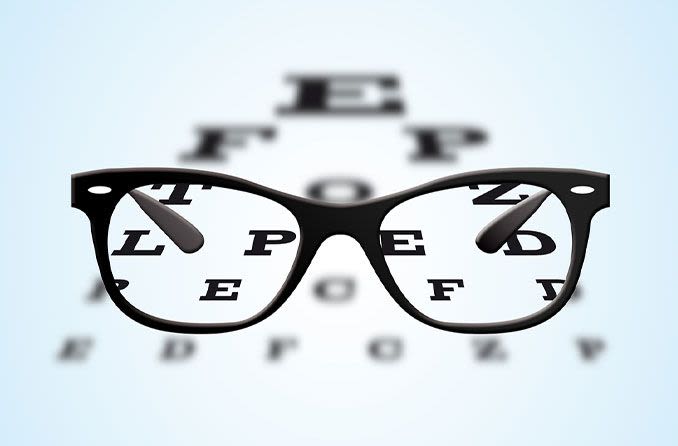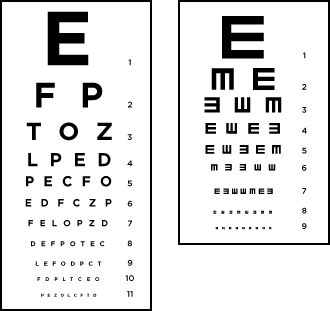Eye and visual acuity tests and the Jaeger eye chart

During an eye test, your optometrist will use a chart of letters ("eye chart") to measure how well you see objects at least 6 metres away. This is called distance visual acuity testing.
If you haven't had an eye test recently, click here to find an optometrist near you.
The classic example of an eye chart is the Snellen eye chart, developed by Dutch eye doctor Hermann Snellen in the 1860s. There are many variations of the Snellen eye chart, but in general they show 11 rows of capital letters. The top row typically contains just one letter (usually the letter 'E'). The other rows contain letters that are progressively smaller in size, with more letters per line.
Download a Snellen eye chart and instructions for use.
During an eye test , your optometrist or ophthalmologist will ask you to find the smallest line of text letters that you can make out, and ask you to read it. If you can read the bottom row of letters, your visual acuity is very good.
What "6/6 (20/20) vision" means in an eye test
The standard placement of the eye chart is on a wall that's 6 metres (20 feet) away from your eyes. Since many optometrists don't have rooms that are 6 metres long, in a smaller room the eye chart may hang behind the patient chair, and mirrors are used to make it appear in front of you at a simulated distance of 6 metres.

How a Snellen eye chart and a "tumbling E" chart might look at your optometrist's office. The tumbling E chart tests the visual acuity of young children and others who can't read letters aloud.
6/ 6 (20/20) vision is considered "normal" vision, meaning if you can read at 6 metres the row of letters on the eye chart designed for a person with normal vision to be able to read at 6m.
Eye charts can be configured in various ways, but generally, if during an eye test you can read the big E at the top but none of the letters lower than that, your visual acuity is considered to be 6/60. That means you can read at 6 metres a letter that a person with normal vision can read at a distance of 60 metres. So 6/60 visual acuity is very poor — roughly 10 times worse than normal eyesight and in some instances can be considered the threshold for being legally blind.
"Tumbling E" eye chart
Sometimes, a standard Snellen eye chart cannot be used.
One example is when the person having the eye test is a young child who doesn't know the alphabet or is too shy to read letters aloud. Other examples include when the person is illiterate or has a handicap that makes it impossible for him to cognitively recognise letters or read them aloud.
In these situations, a modification of the Snellen eye chart called a "tumbling E" chart may be used. The tumbling E chart has the same scale as a standard Snellen eye chart, but all characters on the chart are a capital letter "E," in different spatial orientations (legs of the E pointing up down left or right).
The optometrist asks the person being tested to use either their hand (with their fingers extended) or a model 'E' to show which direction the "fingers" of the E are pointing: right, left, up or down.
Studies have shown that visual acuity measurements using a tumbling E chart are virtually the same as those obtained from testing with a standard Snellen eye chart.
Download a Tumbling E eye chart and instructions for use here.
Near visual acuity: Jaeger eye chart
To evaluate your near vision, your optometrist may use a small hand-held card called a Jaeger eye chart. The Jaeger chart consists of short blocks of text in various type sizes.

A Jaeger eye chart contains several blocks of successively smaller text, generally ranging in size from J10 (large print) to J1 (very small print).
The original Jaeger eye chart was developed in 1867 and contained seven paragraphs, each printed in a successively smaller font size. The smallest paragraph you can read when holding the chart approximately 40 cm away determines your "near visual acuity".
Since then, there have been several modifications of the Jaeger chart (or "Jaeger card") by different manufacturers. Unfortunately, modern Jaeger charts are not standardised, and the actual letter sizes on different Jaeger cards might vary slightly.
The type scale on a modern Jaeger eye chart usually ranges from J10 (approximately 14-point type for Times New Roman font) to J1 (approximately 3-point type, Times New Roman). Some Jaeger charts have an additional paragraph labelled "J1+" that may be even smaller than the J1 block of text.
The J1 paragraph on a Jaeger card typically is considered the near vision equivalent of 6/6 visual acuity on a distance eye chart. On some Jaeger cards, the J1+ paragraph is the 6/6 equivalent.
Common newsprint generally ranges in size between J7 (10-pt type) and J10 (14-pt type), which are the equivalent of 6/20 and 6/30 on a distance eye chart.
A Jaeger eye chart may be used in two different ways, depending on what your optometrist is trying to measure:
The chart is held at a specified reading distance (such as 35cm) and you are asked to read the passage with the smallest type you can see.
The chart is moved forward and back until you are able to read a certain type size.
Download a Jaeger near visual acuity chart and instructions for use here.
Eye chart limitations
Eye charts measure visual acuity only. They help your optometrist figure out whether you need prescription glasses or contact lenses for your distance vision. Good results on a visual acuity test does not guarantee your eyes are healthy.
Eye charts don't measure your peripheral vision, depth perception, colour perception or ability to perceive contrast.
Also they don't measure items related to the health of your eyes, such as your eye pressure, (one factor in determining if you have glaucoma), how dry your eyes are or whether the retina in your eyes are in good shape.
So eye chart testing is just one component of a complete eye test, which you should have every two years.
Page published on Tuesday, 17 March 2020






